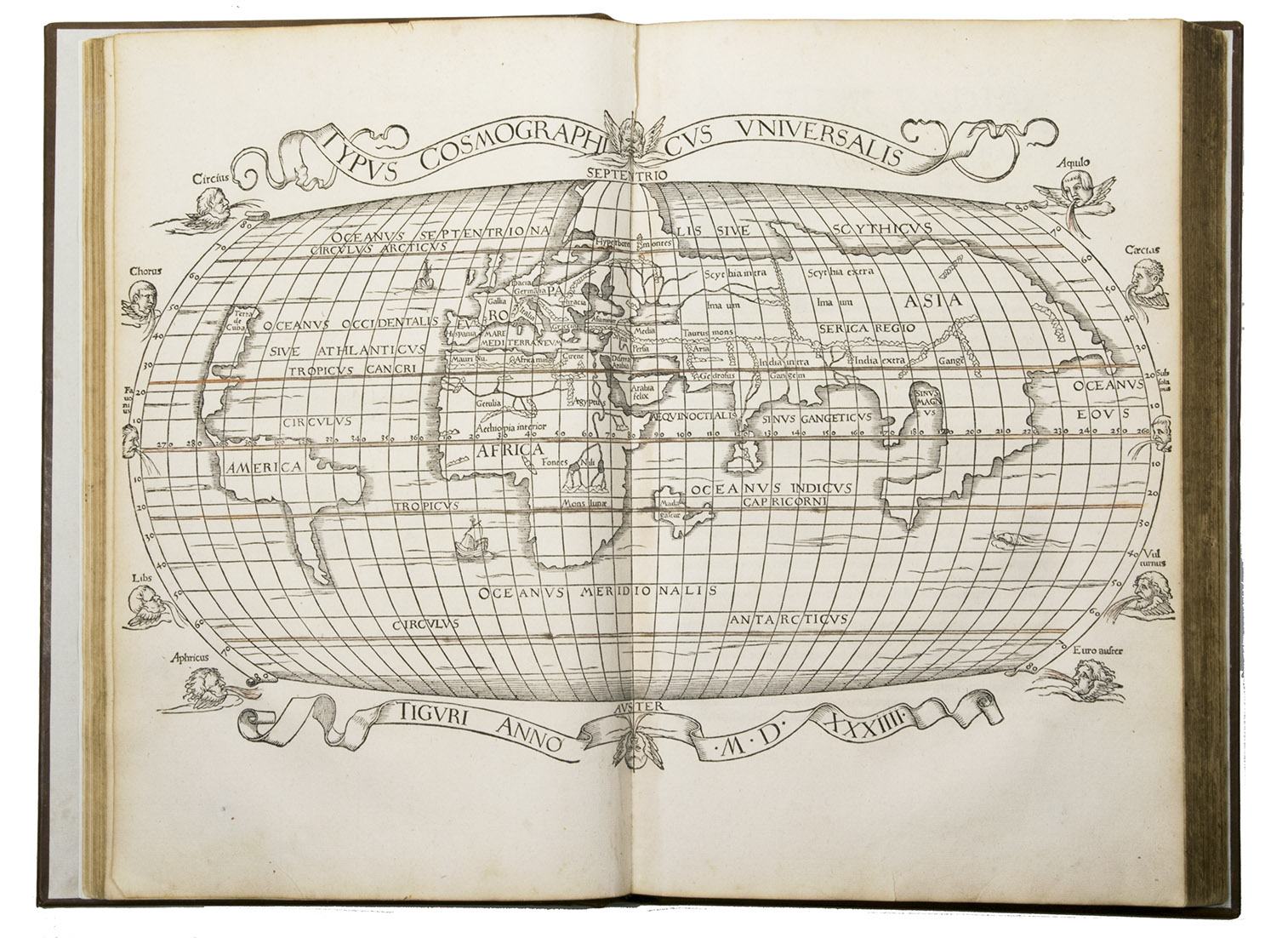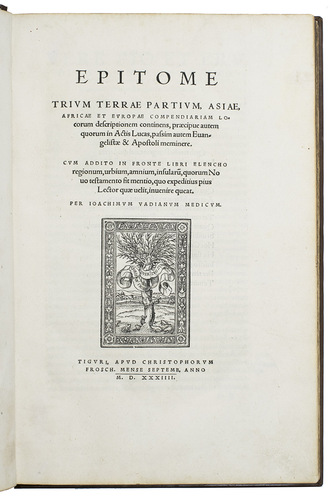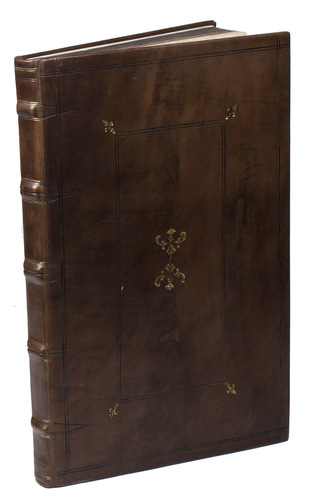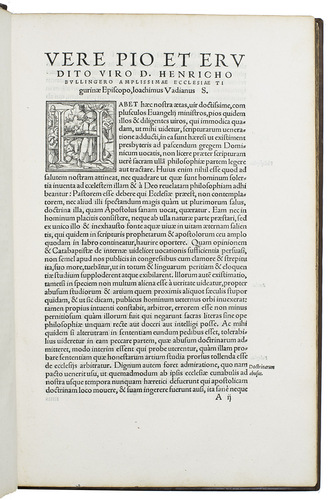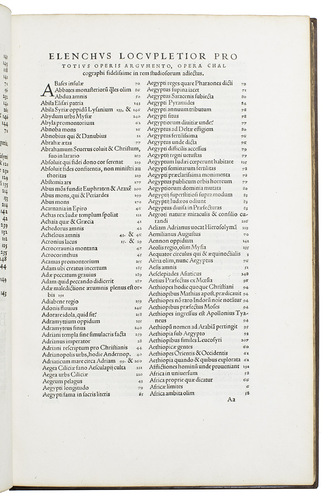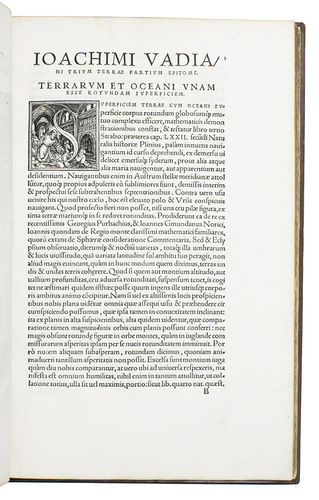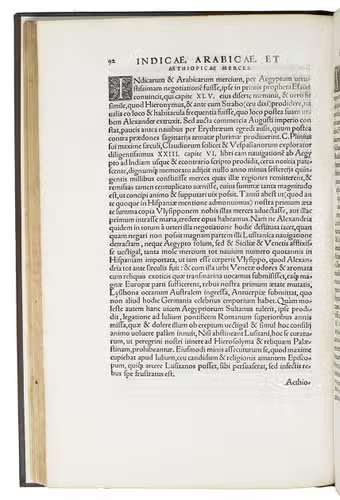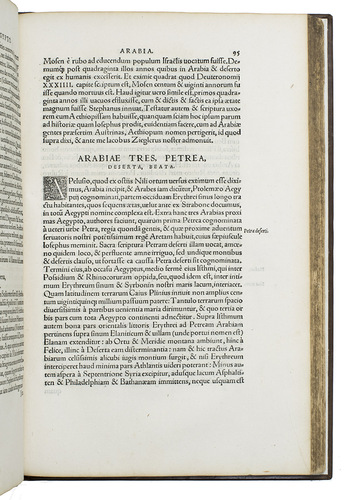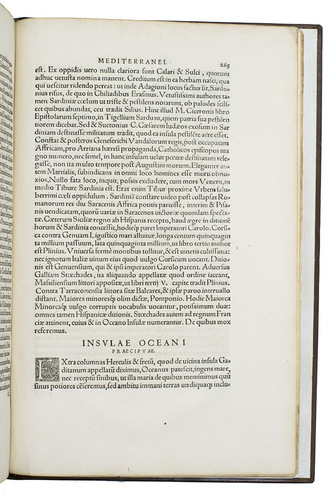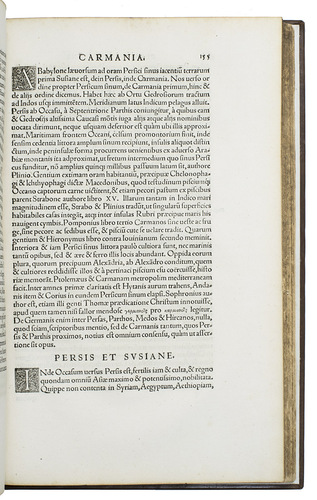VADIANUS, Joachim (Joachim von WATT).
Epitome trium terrae partium, Asiae, Africae et Europae compendiariam locorum descriptionem continens, praecipue autem quorum in actis Lucas, passim autem evangelistae & apostoli meminere. Cum addito in fronte libri elencho regionum, urbium, amnium, insularu[m], quorum Novo Testamento fit mentio, quo expeditius pius lector quae velit, invenire queat.
Zurich, Christoph Froschauer, 1534. Folio. With woodcut printer's device on title-page, numerous decorated woodcut initials and a double page woodcut world map "Typus cosmographus universalis" after Sebastian Münster. Modern calf. [44], 273, [1] pp.
€ 38,500
This significant geographical work is the first edition, and it contains extensive commentary on America and the Holy Land by Joachim Vadianus or von Watt (1484-1551). This copy is one of the few that includes the world map, which depicts America for one of the first times. The map is a general representation on an oval projection, and it is a simplified reduction of the Munster map that was printed in Basel two years earlier. The wood engraving is precise and clear, as noted by Shirley. The map shows South America as a separate continent, while the land to the north is labeled as Cuba.
The first edition of Vadianus' influential work is a comprehensive description of the world. He covers all continents, seas, islands, regions, mountains, and towns of the world, with separate chapters dedicated to Europe, Africa, Asia, Palestine, and even Paradise ("Moreover, there is great demand to know, where Paradise is or has been", p. 181), offering a geographical reading of biblical history. In that same year, a smaller-sized edition was also published, but without the map. This was later followed by several other editions. Vadianus provided an extensive account of the world's geography, including information about the winds of the ocean, the cities and their populations, and the islands of the ocean. He begins with detailed descriptions of different European countries, followed by accounts of various regions in Africa and Asia (including a detailed essay on Palestine) and the Holy Land. Vadianus provides an interesting account of Persia, describing it as the "birthplace of the Persians, a fertile land and cultivated people, ennobled and once the greatest, noblest and most powerful kingdom" (p. 155). Furthermore, Vadianus devotes much of his work to describing the geography of Arabia and praises the virtues and culture of the ancient Arab people who inhabited northern Arabia and the southern Levant, the Natabeans. The two beautiful historiated woodcut initials that appear at the beginning of the book are credited to the reformed Swiss artist and politician Niklaus Manuel Deutsch (c. 1484-1530).
The book includes a highly significant map of the world that features the complete outline of South America, which is a rare occurrence according to Sabin and is not present in many of the existing copies. The map is a reduced-size replica of Sebastian Münster's world map, which was published in Grynaeus Novis orbis regionum ac insularum veteribus incognitarum (Basel, 1532). Münster's map, in turn, was primarily based on Waldseemüller's map of 1507. The world map is a scarce item and is absent from most copies that have survived. This world map is the first to accurately depict the complete outline of South America and the second map to feature this continent. The representation of North America is limited to a narrow strip labeled "Terra de Cuba." The delineation of India and its neighbouring territories is significantly improved in comparison to earlier maps.
Joachim Vadianus, a renowned Swiss scholar, was recognized for his diverse talents in various fields such as mathematics, medicine, humanities, reformation, poetry, and geography. He was associated with Conradus Celtis' humanist group and had multiple meetings with Erasmus in Basel. Vadianus edited the works of various classical authors and in 1523, he lectured on the "Acts of the Apostles" with an emphasis on geography, culminating in his publication of the "Epitome trium terrae partium". The manuscript notes on geography that formed the basis of his publication were initially copied in 1523 by his friend Johannes Kessler and are still preserved in the City Library of St. Gallen (Vadiana, Ms. 64). After completing his studies at the University of Vienna, Joachim Vadianus returned to St. Gall and was granted the titles of poet laureate and "imperial orator" by the Emperor Maximilian in 1514. He obtained his medical doctorate in 1517 and dedicated himself to serving the underprivileged community in St. Gall. He also excelled in several other fields and served as the mayor of St. Gall in 1526. Vadianus played an instrumental role in bringing together the cantons of St. Gall and neighboring areas into the Swiss confederacy. As an author, he wrote on various topics such as Pliny's natural history and the history of St. Gall. He also authored two works on geography, including the "Epitome trium terrae partium" and a commentary on Pomponius Mela. Vadianus gained immense recognition for his poetry and treatises and was particularly lauded for his publication and commentary on the works of numerous classic authors such as Sallust, Ovid, Tacitus, and ancient scientists and geographers like Afer, Pliny the Elder, and Pomponius Mela.
Small worm hole in the outer margin of pp. 175-226, some marginal notes. Very good copy. Adams V-10; Alden & Landis 534/31; Harrisse, BAV 189; JCB I, p. 460; Karrow 58/47.1; Nordenskiold 106; Panzer V, 313, 62; Sabin 98279 (erroneously dated 1533); Shirley 70; USTC 653060 (39 copies); VD 16, V-20 (15 copies).
Related Subjects:
